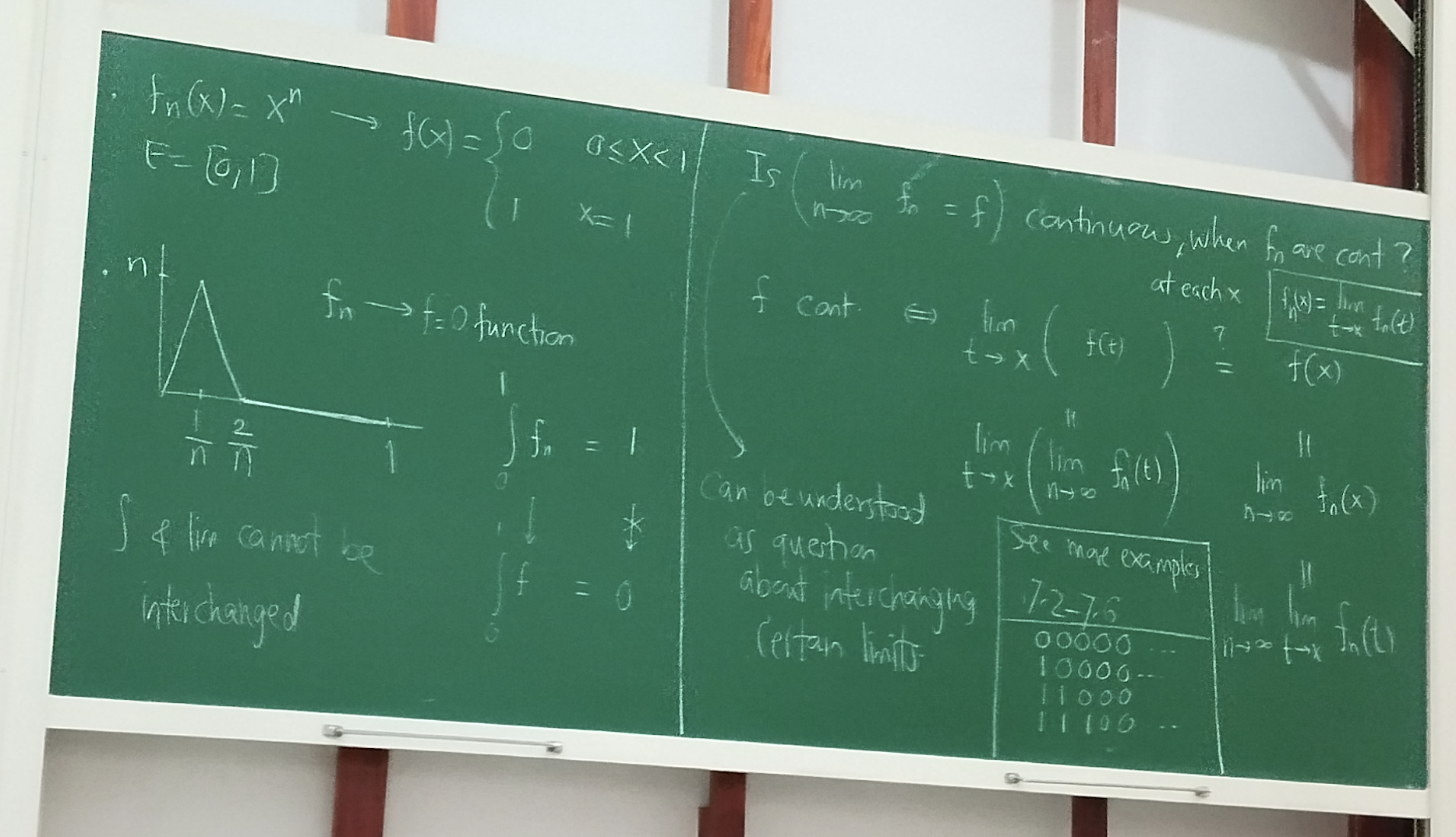
Sequences of functions
Definition 1.
Suppose is a sequence of functions defined on a set , and suppose that the sequence of numbers converges for every . We can then define a function by
Under these circumstances, we say that converges pointwise (or simply converges) on to the limit function .
Definition 2.
Similarly, if converges for every , and if we define
then is called the sum of the series .
We want to determine whether important properties of functions such as continuity and differentiability are preserved under these limit operations. For example, if is a sequence of pointwise convergent functions, and every is continuous, is the limit function continuous? Several easy examples can be constructed with little thought to show that this is definitely not the case. For example, consider the sequence of functions defined by on . Each is continuous. Now, consider the limit function, . For any , converges to . But at , . So, we get
which is clearly discontinuous. So, pointwise convergence does not preserve properties such as continuity. However, a stronger form of convergence, called uniform convergence, does preserve these properties.
Remark
To say is continuous at a limit point means
Hence, to ask whether the limit of a sequence of continuous functions is continuous is the same as to ask whether
(We have used the definition of as the pointwise limit of and the hypothesis that are continuous). So, we are essentially asking whether the order in which limit processes are carried out is immaterial. As said before, this is not true for pointwise convergent functions, but is true for uniformly convergent functions.
Uniform convergence
Recall our definition of uniform continuity and how it was related to vanilla continuity. Something similar will happen here. Notice that the definition of pointwise convergence can be restated like so
Definition 3.
Let . is pointwise convergent if
Compare with the definition of uniform convergence:
Definition 4.
Let . is uniformly convergent if
converges uniformly if and only if
converging uniformly to is denoted by . (The parentheses denoting that are elements of a sequence may periodically be dropped.)
There exist parallel definitions for and .
Now we are ready to watch uniform convergence deliver on its promises.
Results due to uniform convergence
Limit of uniformly converging continuous functions is continuous
Theorem 5(Theorem Rudin, 7.12).
and each continuous on is continuous on .
Proof
Let . We’ll show continuity of at . Let . Pick such that for all . Let such that . Now, if , we have◻
Limit of uniformly converging integrable functions is integrable (and more)
Theorem 6(Theorem Rudin, 7.16).
and each on on and
Proof
Let . Since converges uniformly to , . Now,Consider a partition of . Then, the first inequality above gives us
The above is true for every partition . So, we can take the supremum or infimum on the left (doesn’t matter which, both are equal):
Applying the same idea on the other side gives us
Thus,
Thus, is integrable on .
A not so neat but nevertheless useful result on differentiation
Theorem 7(Theorem Rudin, 7.17).
Suppose
- are differentiable on ,
- , and
- there exists some such that converges.
Then, and for all .
Another way to understand uniform convergence
Let be a metric space. Define
Define a norm on by
Note that this turns into a normed linear space over , since all the properties of the norm are satisfied by our definition:
- for all and . This is easy to see, since if a function is scaled by , its maximum value is also scaled by .
- with if and only if .
- .
Proof of triangle inequality
From the triangle inequality for real numbers, we know that
We know that . This is true for all . Thus, is an upper bound for . Thus, we have
◻️
Note the order in which the suprema were taken in the above proof.
Therefore, we get a metric .
Theorem 8(Claim).
in , i.e, , such that .
Proof
Remark
Consider . Let be the set of all continuous functions on . Now, since continuous functions on compact sets are bounded, . Since the limit of uniformly converging continuous functions is continuous the limit of every convergent sequence in is also in , i.e, is a closed subset of !
Criteria for uniform convergence
The Cauchy Criterion
Theorem 9.
The sequence of functions defined on converges uniformly on if and only if for every there exists an integer such that , , implies
Proof of
There exists such that implies for all . Thus, ,Proof of
The Cauchy criterion for sequences of real numbers tells us that the sequence converges for every fixed . Thus, is pointwise convergent to some function . We need to prove that this convergence is uniform. Choose such that implies for all . Now, keep and fixed, and consider the sequence obtained by incrementing : . All of these are less than . Thus, their limit must also be less than . So, we have
The M-test
Theorem 10.
Suppose is a sequence of functions defined on , and suppose
Then, converges converges uniformly on .
Proof
If converges, then, for arbitrary , from the Cauchy criterion for series,provided and are large enough. Uniform convergence follows from the Cauchy criterion for uniform convergence. Note the implicit use of the triangle inequality above.